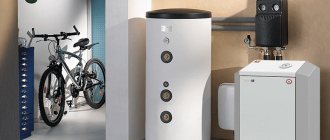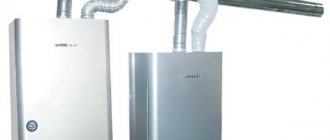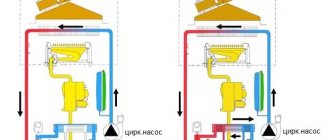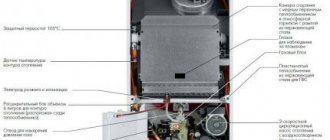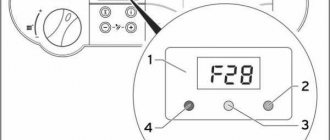The rapid gasification of Russian regions has created a demand for gas boilers of various modifications. The operating principle is based on the combustion of gas in a chamber and heating of a heat exchanger through which water circulates.
Depending on the purpose of the room, area, materials from which the building is constructed, wall-mounted or floor-mounted, single-circuit or double-circuit boilers are chosen, with an open or closed combustion chamber. Floor-standing gas installations are designed for a longer service life; they are part of a boiler room; wall-mounted ones are a mini-boiler room, take up little space, and are ideal for apartments and houses. Single-circuit boilers are intended only for heating, double-circuit boilers are intended for heating premises and producing hot water. Boilers also differ in the type of draft; turbocharged boilers have a closed combustion chamber, while atmospheric boilers have an open combustion chamber.
Regardless of what model of boiler is installed in the room, the safety of the heating boiler directly depends on proper operation and compliance with safety precautions. Gas installations are sources of increased danger and can pose a threat to life due to the careless and neglectful attitude of the consumer. Failure to comply with basic operating rules leads to gas leakage, the appearance of carbon monoxide (carbon monoxide), fire, and in rare cases, an explosion of the installation.
Safety precautions when operating a gas boiler
Safety precautions for gas equipment require strict adherence. Basic requirements for working with gas boilers:
- It is forbidden to open the unit or break the seal of the housing, this can lead to burns, cuts and electric shock.
- You cannot dismantle the boiler yourself; such work should only be performed by a gas equipment installation specialist.
- The power cord must be handled with care; it must not be heated, cut or subjected to other destructive influences.
- You cannot leave or store objects on the surface of the boiler; the vibration that is created by the operation of the installation can cause the object to fall and damage it.
- It is forbidden to climb onto the gas installation; such actions lead to deformation of the fastenings and damage to the boiler.
- The boiler must be cleaned from stable surfaces. Stools and folding ladders can cause a person to fall and damage the boiler.
- Cleaning is carried out only after disconnecting the boiler from the power supply; some components are live.
- It is forbidden to use aggressive cleaning agents or solvents for cleaning.
- It is prohibited to store flammable materials and liquids near the unit.
- You cannot use a gas boiler and safety precautions prescribe this for children and people with limited physical and mental abilities.
- It is unacceptable to operate the boiler at the limit, allow overloads and deviations from the modes prescribed in the instructions.
- If smoke or a burning smell appears in the house, you must disconnect the unit from the network, turn off the main gas tap, open windows or vents, and call a technician.
- If you smell gas, you must turn off the main gas tap in the house, ventilate the room, and call a gas installation maintenance specialist.
It is important to strictly follow the prescribed rules so as not to expose your life and health to undesirable consequences.
Gas boiler operating instructions
Autonomous heating of the house makes it possible to independently regulate the microclimate in the premises, setting the air temperature that is optimal for a particular place. When leaving on a business trip or to a resort, you can turn off the boiler or switch it to low consumption mode. And, accordingly, do not overpay extra money, as happens in apartment buildings connected to a centralized steam heating system.
Since gas is a highly flammable combustible material, its use is associated with an increased level of danger. And only compliance with all precautions can ensure safe operation of the equipment for a long time.
An example of connecting a boiler to a heating system
To increase the level of safety, certain provisions have been adopted at the legislative level that are designed to minimize the risk of fire or carbon monoxide poisoning for users. They are set out in SNiP 11–35–76 “Boiler installations” and SP-41–104–2000 (rules for the design of autonomous heat supply systems)
First of all, these standards are related to the correct installation and connection of a gas-fired boiler. It can only be carried out by a representative of the relevant service, as a rule, an employee of city gas, district gas or regional gas. You can only hang (or install) the unit on your workplace and supply water to it.
Gas connection is permitted only to employees of the installation organization, who draw up a connection report, install seals on the boiler and put the system into operation.
Regulatory documents also regulate the methods of installing a chimney and the requirements for the room in which gas equipment is installed - the boiler room.
To conclude an agreement with a service organization you will need:
- Agreement on the provision of natural gas to an individual developer
- Boiler installation project, agreed upon with a representative of the relevant service that has a license to develop design documentation
- Certificate of installation and connection of the boiler to the gas supply system
A conclusion on the readiness of heating equipment for operation is issued by an engineer from a local gas organization. Before switching on directly, the pipe connection must be checked for leaks under a pressure of up to 1.8 atm, and the air in them must be vented.
In addition, it is recommended to protect the boiler from voltage surges in the network by installing a stabilizing transformer. Ideally, the best solution for problems arising in the electrical network would be to connect an autonomous uninterruptible power supply.
It is prohibited to add antifreeze to the water circulating through the heating channels. This leads to rapid wear of the rubber gaskets, which act as a seal in pipe joints. As a result, liquid leakage and disruption of the specified operating mode of the heating equipment may occur.
The furnace room must have an area of at least 4 m2, the ceiling height must be at least 2.45 m. The size of the entrance door must be at least 0.8 m wide. It is also necessary to have a ventilation window and free air flow. If ventilation is insufficient, a mesh opening is installed at the bottom of the door, allowing air to move unhindered. The hole size is calculated based on the norm of 8 cm2 per 1 kW of power.
Requirements for the location of the gas boiler in the boiler room
The combustion of 2.5 m3 of gas requires about 30 m3 of air! In addition to sufficient air flow, continuous exhaust gas removal is required.
The chimney is installed according to the following standards:
- the diameter of the chimney should not be less than the diameter of the outlet pipe from the boiler;
- more than 3 bends are not allowed from the boiler to the final point of smoke exit;
- the pipe umbrella must rise above the roof ridge by at least 50 cm.
Requirements for installing a chimney pipe for a gas boiler
In order to prevent dangerous gas accumulation in the room, a gas analyzer must be located in the boiler room, which transmits a signal to an electric valve that stops the gas supply. Gas leaks are the most common cause of accidents associated with the operation of gas equipment.
To calculate the cost of gas used for heating, gas meters are used, which are installed on the inlet pipe in front of the boiler.
Installation of equipment must provide for a safe location of the boiler away from walls and windows. If the wall is made of flammable material (for example, wood), then it is necessary to use a sheet metal gasket with a thickness of at least 0.5 mm. It is not recommended to install the boiler directly next to a window.
To prevent the heat exchanger from becoming clogged over time, a mesh filter is installed on the pipe entering it. Ball valves on both sides will greatly facilitate its further replacement and maintenance.
Service life
The service life of gas equipment is determined in the technical passport of the boiler and ranges from 10 to 15 years. However, with regular maintenance and prevention, it can last much longer. The regulatory services may establish additional requirements for service life.
This may be due to the presence (or absence) of spare parts that are needed in the process of maintaining full operation of the boiler. If during the repair some part is required, and the manufacturer has stopped producing them, it may be necessary to replace the boiler as a whole with a more modern one and one equipped with spare parts.
Service
Current technical maintenance and repair of boilers is undertaken by the company that supervises the safety of using this type of equipment. This is reflected in the agreement concluded between the consumer and the local gas service office. As a rule, inspection is carried out once a year, before the start of the heating season. The service representative is obliged to test the operation of the main technical components of the unit and draw up an inspection report, a copy of which remains in the hands of the consumer. If any deviations from normal operation are identified, the inspector’s task is to draw up an order that reflects the essence of the problem and the time frame for its elimination.
In order for the boiler to work properly and without failures, you must adhere to certain rules that are easy to follow, but neglecting them can lead to serious and unpleasant consequences.
Extreme situations associated with the operation of gas installations
If you smell gas:
- turn off all electrical heating devices;
- do not use electric light switches or light lamps;
- increase ventilation in the room, open all possible windows and doors;
- close the gas shut-off valve to the “Closed” position (perpendicular to the pipe on which it is installed);
- Call the emergency gas service.
If you smell carbon monoxide:
- stop the boiler operation;
- increase ventilation by opening as many windows and doors as possible;
- Call the emergency gas service.
It should be taken into account that the telephone also operates on electric current, so calls must be made at a safe distance from a gas-filled or smoke-filled room.
During boiler maintenance, for example, replacing fuses in the electrical supply system, the boiler should be completely disconnected from the network. Only by unplugging the cord from the outlet can you proceed to further actions.
If a leak occurs in the heating pipes and restoration work is carried out, it is necessary to drain all water from the boiler. The boiler can be started again only after the leak has been eliminated and air has been bled from the pipes.
During the cold season, when the air temperature outside drops to low levels, ice can form on the chimney, which, when falling off, can cause harm to people's health. To prevent this from happening, special ice catchers are installed on the roof or on the pipe itself.
The general rules for installing boilers also stipulate that they can only be placed in rooms protected from freezing. It is prohibited to store or use substances with a high level of explosion hazard, such as gasoline, solvents, paint or varnish, in the boiler room.
To care for the boiler, use only damp cloths and mild detergents. Only a specialist can clean the area under the boiler casing.
Correctly adjusting the heating mode significantly reduces costs.
Heat distribution throughout the premises is carried out in two ways:
- manual adjustment of thermostats directly on radiators;
- using a remote control system, by installing climate control sensors.
A good help in saving money is a device that reduces the temperature at night. A change in temperature of 1 degree changes gas consumption by 5–7%.
For effective air circulation around heating radiators, it is necessary to create favorable conditions. Heavy curtains covering the radiator body prevent this and, accordingly, increase energy consumption. At the same time, curtains that tightly cover the glass of the windows help reduce the cooling of the air in the room in winter. By correctly selecting the size and location of curtains, you can further reduce gas consumption.
Design of a niche for a heating radiator
The economical distribution of heat is facilitated by such trifles, insignificant at first glance, as thermal insulation of niches for the location of batteries and painting them in light colors. It is estimated that these measures reduce gas consumption by up to 3%.
In addition, if it is necessary to ventilate rooms, short but frequent openings of doors and windows are recommended. With prolonged ventilation, the walls that accumulate heat cool down and then have to be warmed up again.
A lot of excess energy is absorbed by excess air in the heating pipes. Removing it from the closed system in a timely manner will reduce costs. For the same reasons, it is not recommended to overheat the liquid to the point of boiling. In addition to the formation of steam bubbles, this condition is also fraught with exceeding the rated pressure and additional load on the joints. Micro leaks can form at pipe joints, through which water will leak over time.
It is advisable to use a hot water recirculation pump. The optimal form of its connection is through a time relay, which can be programmed in accordance with the hours of active hot water consumption.
Using a shower instead of a bath reduces hot water consumption by up to 30%.
An important factor in energy saving is sealing the cracks of windows and the front door. Modern sealing means eliminate the movement of cold air even in old, dry windows.
In order to prevent the wick from blowing out on a boiler operating in automatic mode, there should be no persistent drafts in the boiler room. The device itself should be located away from doors or windows so that when the door slams, the air wave cannot extinguish the flame of the wick.
Video: gas double-circuit boiler NAVIEV 24, review and feedback
There are a great variety of heating boiler models. They vary in size, power and purpose. There are purely heating units, and there are double-circuit boilers that combine the function of heating a room with the supply of hot water for domestic needs. Depending on the brand, they may differ in equipment, presence or absence of automation and various types of adjustments. Some are designed for small rooms and are mounted on brackets to the wall, others are installed on the floor, have large dimensions and are designed to heat large areas.
Each type has its own operational features, which are described in the technical documentation. Careful study of the product data sheet and instruction manual will allow everyone to understand all the nuances of connecting and using exactly the model that has been chosen.
Video: start-up and switching on of the gas boiler AOGV-8–1 “Gazovik”
Operation and maintenance of a gas boiler
Many manufacturers equip gas boilers with various protections: against freezing, overheating, scale formation, gas leaks, pressure loss in the heating circuit. The models are equipped with self-diagnosis, self-shutdown when smoke appears or when there is a gas leak, but for long-term and high-quality operation of the boiler, each user must know how to use the heating boiler correctly. Basic recommendations for operating gas equipment:
- It is not recommended to install the boiler in rooms with high humidity and temperature; the metal parts of the boiler rust, and scale appears faster.
- It is not allowed to carry out construction or repair work near the boiler; dust settles on the circuit boards and heat exchanger, which reduces the efficiency of the installation and can damage it.
- A filter is installed in the boiler to purify water. Contaminants can cause blockages in the heating and hot water circuits.
- You should monitor the heating circuit, regularly flush the pipes, and check for leaks. The interaction of air and water in the heating system should be minimized.
- It is recommended to keep the burner clean and clean it if necessary. Timely action will prevent excessive fuel consumption and operational inefficiency.
- A boiler with an open combustion chamber must provide a constant flow of air. Lack of oxygen reduces the efficiency of the installation.
- It is necessary to regularly check and clean the chimney and ventilation duct system.
- It is necessary to monitor the water level and pressure in the heating circuit.
- Add water to the system only after it has cooled to avoid temperature imbalances.
- In the heating system, the temperature should not exceed 95 degrees and fall below 45 degrees Celsius. Overheating can lead to system breakdown; low temperatures promote condensation.
- The boiler should be inspected at least once a year, and ideally twice. A specialist will identify problems and fix them, replace damaged parts, remove scale that reduces heat transfer, clean the chimney, poor draft reduces the performance of the installation.
- Also, in accordance with the standards of the Federal Law “On Environmental Protection”, the user is responsible for the gas installation, he is responsible for its environmental safety.
Following these simple rules will ensure proper operation of your gas boiler for several decades.
Operating principle of gas boilers
A gas boiler is the main heating element of the heating system and hot water supply in the house. There are the following varieties and types of heating gas boilers:
- floor;
- wall;
- single-circuit;
- double-circuit;
- atmospheric;
- turbocharged.
Each type has differences, but the basic principle of operation is the same for all types - through the combustion of gas, the coolant is heated, circulating through a closed system circuit. The second name of the system is the circulation circuit. More often, the coolant is water that has gone through a water treatment cycle . The preparation cycle keeps the circulation pipes in working condition for a long time, due to the absence of scale on the walls.
The circulation system, in addition to the boiler itself, includes the following devices: circulation pumps, boilers, shut-off valves and heat exchange devices (radiators, batteries).
Models of gas installations and their technical characteristics
Gas heating boilers of various modifications and manufacturers are collected on the website santechbomba.ru. For example and reference, the technical characteristics of several models are presented:
Gas boiler Daewoo GasBoiler DGB-130 MSC
The reliable and durable Daewoo wall-mounted double-circuit gas boiler has a modern, ergonomic design. A boiler with a closed combustion chamber has a convenient control panel with a display that displays digital values, set modes, and a simple interface. The heat exchanger for the heating circuit is made of copper. The boiler power is 15 kW, the efficiency is more than 90%, it is designed to heat a room up to 150 sq. m., good hot water performance. Compact dimensions and light weight make the model convenient for any room; the boiler does not take up space.
Gas boiler Baxi ECO 5 Compact 1.14 F
An Italian single-circuit gas boiler is ideal for an apartment with autonomous heating. The installation is wall-mounted, with a closed combustion chamber. The heat exchanger is made of copper, its service life is much longer than that of its aluminum counterpart. The boiler efficiency is almost 93%, the power is 14 kW, this model can heat up to 140 square meters of living space. The unit has an attractive design, an easy-to-use control panel with an LCD screen and weather-compensating automation. The model is equipped with built-in protections, smooth electronic ignition and the ability to connect to solar collectors.
Gas boiler Mimax KSG-20
The Russian-made floor-standing boiler is distinguished by its reliability and excellent performance characteristics. Mimax double-circuit boiler with an open combustion chamber. The high power of the installation - 20 kW and efficiency - 92% allows you to heat up to 200 sq.m of living space. High productivity of hot water. The weight of the unit is 62 kg, control occurs by increasing/decreasing power. The model has a 15-year warranty.
Gas boilers differ in power characteristics and performance; models have various built-in functions and protections. Gas boilers are selected based on the technical characteristics of a house or apartment, taking into account the capabilities and preferences of the consumer. A gas boiler must have a power reserve of at least 10%.
When choosing a gas installation for heating your home, you should not neglect safety. It is necessary to monitor the technical condition of the equipment, check the tightness of connections in circuits, chimney and gas supply systems. Compliance with simple requirements and proper operation will protect the house from emergency situations.
30.09.2017
Return to list
Safety precautions during operation
To prevent accidents and other problems, you should carefully study the operating instructions for the solid fuel boiler.
The basic rules are as follows:
- avoid close contact with the operating device;
- do not leave plastic buckets, wood or other flammable objects near the heat generator;
- do not leave the device unattended;
- do not allow complete evaporation of the coolant during combustion in order to avoid corrosion and rupture of pipes and radiators;
- regulate the air supply to the fuel using the ash door;
- do not place various objects on the boiler;
- when water boils in the system, close the chimney and vent dampers to prevent complete evaporation of water in the expansion tank and pipes;
- Fill the tank with water promptly.
If you have a choice, it is worth installing a forced closed-type system, which will facilitate the operation of the equipment.

